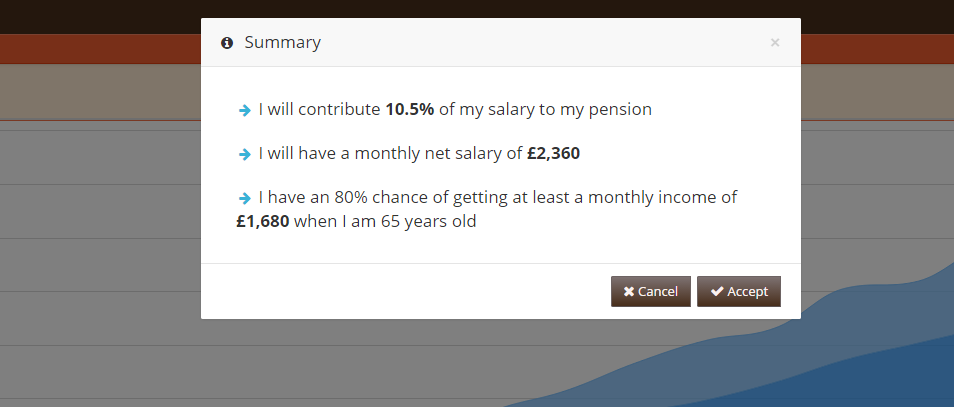Diálogo
Un diálogo es un elemento gráfico que proporciona la funcionalidad de mostrar una ventana modal con un mensaje y título seleccionados (y un icono, si se quiere). A dialog should be associated to a button-action with type "dialog" (See button actions).
Esqueleto de XML
<dialog id="[dialog-identifier]" label="[dialog-label]" icon="[dialog-icon]"
modal="[is-modal-screen]" style="[dialog-style]" help="[dialog-help]" on-close="[on-close]">
[define the content of the dialog]
</dialog>
Estructura de diálogo
| Elemento | Uso | Varias instancias | Descripción |
|---|---|---|---|
| dialog | Required | No | Nodo global del diálogo. Define los atributos del diálogo |
Atributos de diálogo
| Atributo | Uso | Tipo | Descripción | Valores |
|---|---|---|---|---|
| id | Opcional | String | Identificador del diálogo. Con fines de referencia | |
| label | Opcional | String | Título del diálogo | Note: You can use i18n files (locales) |
| icon | Opcional | String | Identificador de icono | Note: You can check all iconsets at icons screen |
| style | Opcional | String | Estilo de la pantalla (clases de Css) | CSS classes separated by space (' ') |
| ayuda | Opcional | String | Texto de ayuda que quieres mostrar | El nombre de un literal con el mensaje |
| on-close | Opcional | String | Comportamiento de la pila después de cerrar el diálogo | accept (default), reject- Reject cancels the stack, accept continues executing stack actions |
Note: You can add the styles
modal-lg,modal-mdormodal-smto change the width of the dialog.
Ejemplos
Diálogo estándar con título, cuerpo y pie de página
Este es un ejemplo con un diálogo definido dentro de una etiqueta modal en una pantalla. En primer lugar, la acción relacionada con el diálogo (en el atributo target).

<button id="SetContribution" button-type="submit" label="BUTTON_SET_CONTRIBUTION" icon="floppy-o">
<button-action type="filter" target="Resume" />
<button-action type="dialog" target="Summary" />
</button>
<dialog id="Summary" label="SCREEN_TEXT_SET_CONTRIBUTION" icon="info-circle">
<tag type="div" style="modal-body scrollable">
<tag-list type="div" id="Resume" target-action="Resume" autoload="true">
<tag type="div" style="text-bg padding-sm">
<tag type="i" style="fa fa-arrow-right text-info fa-fw" />
<tag>
<text> [Value]</text>
</tag>
</tag>
</tag-list>
</tag>
<tag type="div" style="modal-footer">
<tag type="div" style="pull-right">
<button label="BUTTON_CANCEL" icon="close" id="ButDiaCan">
<button-action type="close" target="Summary" />
</button>
<button label="BUTTON_ACCEPT" icon="check" id="ButDiaVal" button-type="submit">
<button-action type="server" server-action="maintain" target-action="SetContribution" />
<button-action type="close" target="Summary" />
</button>
</tag>
</tag>
</dialog>
Diálogo estándar en una nueva pantalla
Este ejemplo muestra una pantalla de diálogo incluida en la sección modal de una ventana.

<button icon="print" label="BUTTON_PRINT" id="ButPrn" button-type="button">
<button-action type="validate"/>
<button-action type="dialog" target="PrnOpt"/>
</button>
<include target-screen="PrnOpt" target-source="center"/>
<screen xmlns:xsi="http://www.w3.org/2001/XMLSchema-instance" xsi:noNamespaceSchemaLocation="https://aweframework.gitlab.io/awe/docs/schemas/screen.xsd" template="window">
<tag source="center">
<dialog id="PrnOpt" modal="true" style="normal" label="SCREEN_TEXT_PRINT_EMAIL" icon="print" help="HELP_SCREEN_TEXT_PRINT_EMAIL">
<tag type="div" style="modal-body row">
[body content]
</tag>
<tag type="div" style="modal-footer">
[footer content]
</tag>
</dialog>
</tag>
</screen>